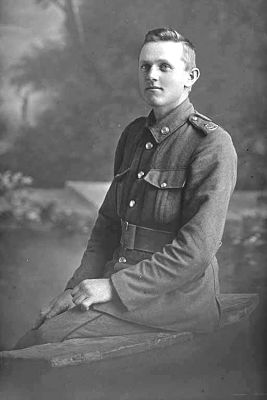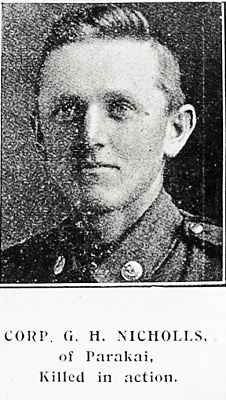WW1 Lance Corporal George Henry Nicholls 12/609
George Henry Nicholls was the younger son of Sarah and Richard Nicholls of Parakai, Helensville. He was born on 27 October 1892 and educated at Remuera Primary School and Helensville.
At the outbreak of the war he was farming with his parents at Parakai and was one of the first to enlist. The Kaipara and Waitemata Echo reported: Those examined and who passed the Doctor’s examination for the front include five men of the local Platoon (No. 9) of “C” Company, namely, Capt. A. K. Gray, and Prs. G. H. Nicholls, H. E. McKenzie, — Hill, and E. E. Judge. These men leave here for the Consentration Camp at Epsom, on Saturday, per mid-day train. [1]
On 16 Oct 1914 to 3 December 1914 George travelled to Suez on the Waimana with the Auckland Infantry Battalion and after training embarked on 12 April 1915 for the Dardanelles (Turkey) from Alexandria. On the 29 July 1915 George was wounded and admitted to No. 2 Australian Stationary Hospital at Mudros on the island of Lemnos, in the north Aegean Sea about 50 miles from the Dardanelles. He rejoined his unit at Gallipoli in the Dardanelles on 13 August but was transferred back to Mudros to the No. 1 Australian Stationary Hospital on 7 September. On 25 September he was reported as being on the Hospital Ship Franconia disembarking at Malta where he was admitted to hospital as “slightly sick”. By 31 October he was able to sail for England on the Panama, arriving on 5 November 1915. He was then admitted to Lord Derby Hospital at Warrington in Cheshire, halfway between Liverpool and Manchester. He convalesced at Hornchurch hospital in Essex from 24 March 1916 and his record notes he was absent 15 hours “off-pass” and had to forfeit one day’s pay. [2] On 7 April 1916 George transferred from the Auckland Infantry Regiment in Ismailia, Egypt to the Wellington Infantry Regiment and on 9 April 1916 embarked on the Llandovery Castle for France from Alexandria. George was appointed Lance Corporal in France on 25 March 1917. On 8 June 1917 he killed in action at the Battle for Messines, aged 24. The New Zealand Herald reported –
MEN WHO HAVE FALLEN. CORPORAL G. H. NICHOLLS. Corporal George H. Nicholls, killed in action at Messines, was the youngest son of Mr Richard Nicholls, of Parakai, Helensville. He was educated at the Remuera and Helensville schools. At the outbreak of the war he was engaged in farming with his parents at Parakai and was one of the first to enlist. From Gallipoli he was invalided to Malta, and subsequently to England. On his recovery he went to Egypt, and from there to France. He had passed unscathed through the battles of Amentieres and the Somme and various minor raids. Writing to his parents, Lieutenant Walter Gibbs in whose platoon corporal Nicholls served, says:—”At the time he met his death I was taking the Lewis guns to a portion of the line beyond Messines, where we were urgently needed. We had to cross the ridge in the open, and, as it was almost mid-day, we were seen, with the result that we were shelled. Your boy was the only unfortunate one, being hit by a piece of shell while sheltering for a brief moment in a trench. He died as a brave lad should, showing no sips of fear under the heaviest of fire. He was a lad to be proud of.” [3] George Nicholls is remembered on the Remuera Primary School memorial gates, the Messines Ridge (New Zealand) Memorial, Messines Ridge British Cemetery, Belgium and the Kaipara Memorial RSA, 49 Commercial Road, Helensville.

